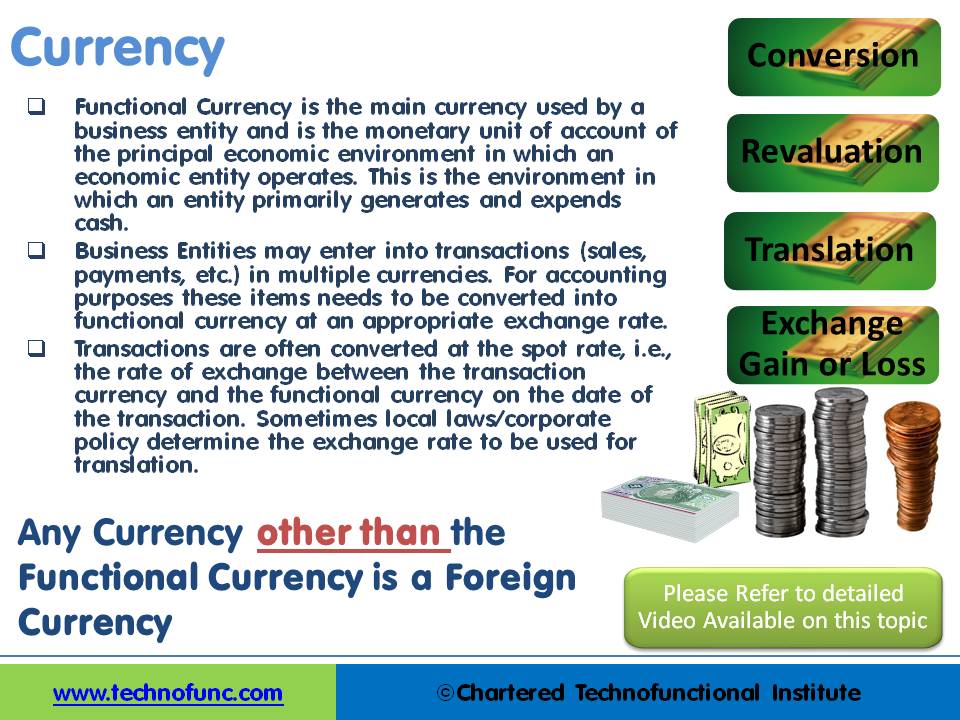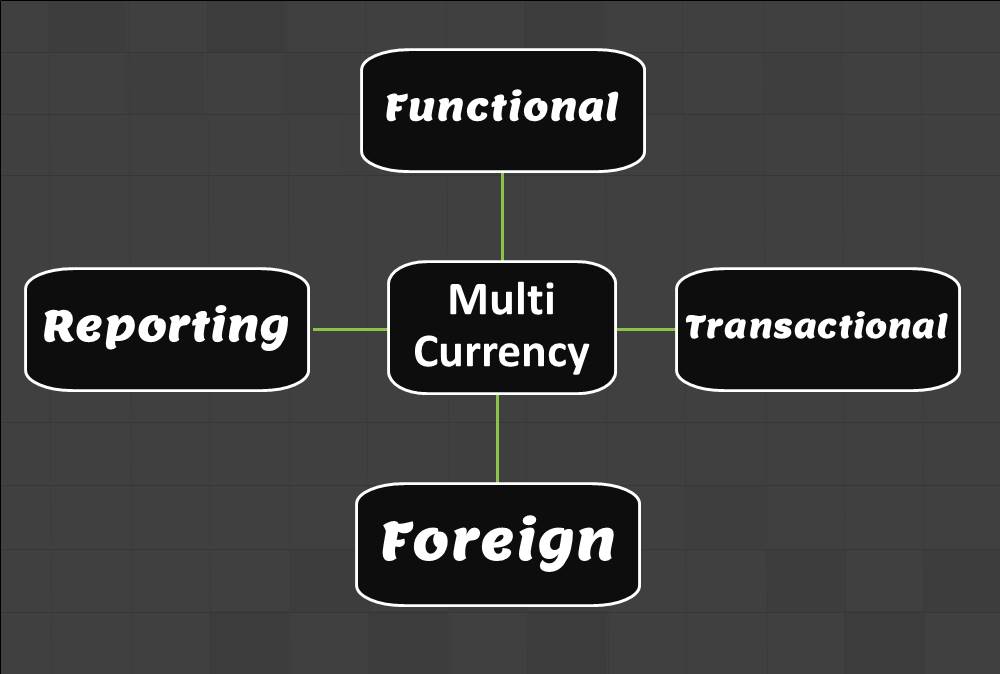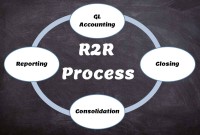- Home
- Business Processes
- Industry Knowledge
- Aerospace Industry
- Automotive Industry
- Banking Domain
- BFSI Industry
- Consumer/ FMCG Industry
- Chemicals Industry
- Engineering & Construction
- Energy Industry
- Education Domain
- Finance Domain
- Hospitality Domain
- Healthcare Industry
- Insurance Domain
- Retail Industry
- Travel and Tourism Domain
- Telecom Industry
- Leadership Skills
- eLearning
- Home
- Functional
- General Ledger (Record to Report)
- Multi Currency - Functional & Foriegn
Multi Currency - Functional & Foriegn
Currency is the generally accepted form of money that is issued by a government and circulated within an economy. Accountants use different terms in the context of currency such as functional currency, accounting currency, foreign currency, and transactional currency. Are they the same or different and why we have so many terms? Read this article to learn currency concepts.
What is Currency?
Currency is the generally accepted form of money that is issued by a government and circulated within an economy. Currency is used as a medium of exchange for goods and services. Every nation has its own currency and global trade results in the exchange of currencies of different countries. Currency is the basis for trade and when the trade involves two different countries, generally two different currencies come to play. To obtain another country’s currency, it is necessary to buy it using the appropriate exchange rate, and the price of a currency compared to another is called the exchange rate.
What is Exchange Rate?
Exchange Rate is the price of one country's currency expressed in terms of another country's currency. In other words, the rate at which one currency can be bought or exchanged for another currency. For example, the higher the exchange rate for one Euro in terms of one Dollar, the lower is the relative value of the Dollar. Exchange rates are determined by the foreign exchange market, where continuous trading happens between a wide range of different types of buyers and sellers. There are different types of rates that get referenced with respect to General Ledger. The Spot Exchange Rate refers to the current exchange rate. The Forward Exchange Rate refers to an exchange rate that is quoted and traded today but for delivery and payment on a specific future date. Historical Exchange Rate refers to the exchange rate prevalent on the date of the original transaction.
1. What is Accounting Currency?
Accounting Currency is the monetary unit used while recording transactions in the company's financial books. The accounting currency may not necessarily be the same as the currency used by the customers when conducting the transaction. Multinational companies are likely to use their home country's currency when recording transactions, even if the sale was denominated in a foreign currency.
For example, an American firm conducting business in Japan will likely use the Dollar as the accounting currency, even if sales transactions are conducted using the yen. The American company is under a legal obligation to consolidate its accounts for operations all over the world in the US Dollars for reporting its results in the US. Hence for its US consolidation books, it will always account for in the US Dollar.
2. What is Functional Currency?
Functional Currency is the main currency used by a business entity. It is the monetary unit of account of the principal economic environment in which an economic entity operates. This is the environment in which an entity primarily generates and expends cash. SFAS 52 introduced the concept of functional currency, defined as "the currency of the primary economic environment in which the entity operates; normally, that is, the currency of the environment in which an entity primarily generates and expends cash."
To understand these learners need to understand the context in which the functional currency term is being used. The functional currency term is generally used in the context of an entity. It is the main currency of the economic environment in which the entity operates. Hence if a US Corporation, registered in the US, is operating in India as a separate registered Indian legal entity, then the functional currency for the Indian legal entity will be INR as that is the currency of the main economic environment. However, if the parent entity drives its 90% of revenues from operations in the US then the functional currency for the parent entity still remains US Dollar.
As a general practice, the functional currency is used as an accounting currency for the respective legal entity. The main reason is that many countries have laws and standards that sometimes prescribe accounting books to be maintained in the functional currency for local statutory reporting needs. Businesses may enter into transactions (sales, payments, etc.) in multiple currencies. Each legal business entity of the business translates these items to its functional currency at an appropriate exchange rate. It then prepares periodic reports of its position (balance sheet) and activity (income and cash flow statements) in that functional currency. When various legal entities are combined, these reports are translated and consolidated to become financial statements. The translation and consolidation need to happen in the functional currency of the parent entity.
3. What is Transacting Currency?
Transacting currency is the currency that customers see and deal with when conducting a transaction, such as a sale. The accounting currency may not necessarily be the same as the transacting currency. Companies are likely to use their home country's currency (Accounting Currency) when recording transactions, even if the sale was denominated in some other currency (Foreign Currency). For example, a US Company conducting business in India will most likely use “US Dollar(USD)” as the accounting currency, even if sales transactions are conducted using the “Indian Rupee(INR)”. In this scenario, the US Dollar is the accounting currency and Indian Rupee is the transacting currency.
For companies having operations in different countries across the globe, managing multiple currencies could be a complicated task due to the interplay of foreign exchange rates and the need to make conversions from one currency to another. Whenever the business entities enter into transactions (sales, payments, etc.) in multiple currencies, for the purposes of accounting, these items need to be converted into accounting currency (the functional currency) at an appropriate exchange rate. Transactions are often converted at the spot rate, i.e., the rate of exchange between the transacting currency and the functional/accounting currency on the date of the transaction. Sometimes local laws/corporate policy determine the exchange rate be used for this conversion.

4. What is Foreign Currency?
From a functional and business perspective Foreign Currency is the currency of another country. From an accounting perspective, any Currency other than the Accounting Currency is a Foreign Currency. For a company that maintains its accounting books in US Dollars any other currency apart from US Dollars is a foreign currency and needs to be converted to US Dollars for recording transactions in the financial books for that entity.
5. What is Basic Currency?
Some accountants use the term basic currency or base currency. They are generally referring to the accounting currency. The amounts referring to different currencies cannot be totaled directly. It is necessary to have a basic currency to refer to and to use for the totals. The main point of accounting is that the totals of the “debit” balances must correspond to the totals of the “credit” balances. To verify that the accounting is balanced, there must be a single currency with which to do the totals. If there are different currencies, the basic currency must be indicated before anything else. This basic currency becomes the accounting currency for recording transactions.
6. What is Account Currency?
Most of the automated accounting systems provide the functionality to record both the transacting currency balances as well as accounting currency balances side by side against each transaction. Uses can enter the transactions in foreign currency and they are translated using the daily exchange rate to the accounting currency. Users can associate a currency with an account to specify the currency in which all transactions pertaining to that account will be entered. For example, you have some foreign currency deposits with the bank. You may specify that currency to prevent errors in your deposit account. In that case, such accounts will have its own currency symbol which indicates in which currency the account will be administered. Once the user indicates what the currency of the account will be, such accounts will then have their own balance expressed in their own currency. Only entries in the specified currency will be permitted on such accounts. If the account is in Euro, then there can only be Euro entries on such account; if the account is in USD, then there can only be entries in the specified USD currency on that account. For each account, alongside the balance in the account’s own currency, the balance in accounting currency will also be kept, in order to calculate the trial balance in accounting currency.
7. Reporting Currency
A company may want to report its financial results in any currency that is other than the functional or the transacting currency. Such a currency being used for reporting the financials is called Reporting Currency. A process of translation is used to convert the balances from one currency to the reporting currency. Currency specific adjustments are made and accounts are reported,
Multi-Currency Concepts
For companies or accounting users managing multiple currencies, the interplay of foreign exchange rates and conversions can make the maintenance of the books a complicated task. Translation of statements may result in translation differences, which are accounted for as a cumulative translation adjustment. Businesses using the accrual method of accounting may recognize revenue or expense in one period and receive or pay it in another. In the intervening period, the exchange rate may have changed. When an accrued item is settled, the difference due to exchange rate movement in the amount accrued and the amount settled is treated as foreign exchange gain or loss. Applicability of multi-currency creates a need to understand some foreign currency concepts like conversion, translation, revaluation, and currency exchange gain & loss. These concepts have been covered in our tutorial on Multi-Currency Concepts.
Related Links
You May Also Like
-
Matrix Organizational Structures
In recent times the two types of organization structures which have evolved are the matrix organization and the network organization. Rigid departmentalization is being complemented by the use of teams that cross over traditional departmental lines.
-
What is Accounting & Book Keeping
Accounting is a process designed to capture the economic impact of everyday transactions. Each day, many events and activities occur in an entity, these events and activities are in the normal course of business; however, each of these events may or may not have an economic impact. Events or activities that have an effect on the accounting equation are accounting events.
-
In this article we will discuss various types of "Management Entities". Various types of operational units, are created by management, to effectively run, manage and control their business. Different types of functional units, and divisional units, are widely used across industry.
-
When the quantum of business is expected to be moderate and the entrepreneur desires that the risk involved in the operation be shared, he or she may prefer a partnership. A partnership comes into existence when two or more persons agree to share the profits of a business, which they run together.
-
As the business grows, the company may want to transition to a branch structure as branches are allowed to conduct a much broader range of activity than representative offices. Branches can buy and sell goods, sign contracts, build things, render services, and generally everything that a regular business can do. A company expands its business by opening up its branch offices in various parts of the country as well as in other countries.
-
In every journal entry that is recorded, the debits and credits must be equal to ensure that the accounting equation is matched. In this article, we will focus on how to analyze and recorded transactional accounting information by applying the rule of credit and debit. We will also focus on some efficient methods of recording and analyzing transactions.
-
Record to report (R2R) is a finance and accounting management process that involves collecting, processing, analyzing, validating, organizing, and finally reporting accurate financial data. R2R process provides strategic, financial, and operational feedback on the performance of the organization to inform management and external stakeholders. R2R process also covers the steps involved in preparing and reporting on the overall accounts.
-
Horizontal or Flat Organizational Structures
Flat organizational structure is an organizational model with relatively few or no levels of middle management between the executives and the frontline employees. Its goal is to have as little hierarchy as possible between management and staff level employees. In a flat organizational structure, employees have increased involvement in the decision-making process.
-
Learn the typical accounting cycle that takes place in an automated accounting system. We will understand the perquisites for commencing the accounting cycle and the series of steps required to record transactions and convert them into financial reports. This accounting cycle is the standard repetitive process that is undertaken to record and report accounting.
-
Network Organizational Structures
The newest, and most divergent, team structure is commonly known as a Network Structure (also called "lean" structure) has central, core functions that operate the strategic business. It outsources or subcontracts non-core functions. When an organization needs to control other organizations or agencies whose participation is essential to the success, a network structure is organized.
Explore Our Free Training Articles or
Sign Up to Start With Our eLearning Courses

About Us
Learning
© 2023 TechnoFunc, All Rights Reserved










